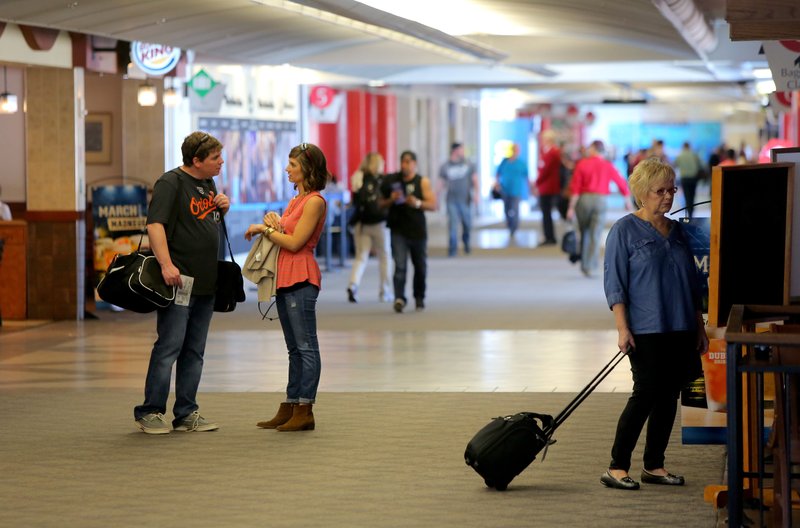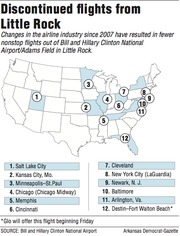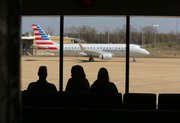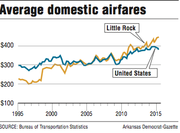A change in how the airline industry operates as a result of mergers and consolidation in recent years has led to fewer airlines and airport hubs, according to industry members.
And for passengers flying out of some airports, including Bill and Hillary Clinton National Airport/Adams Field in Little Rock, this transformation has resulted in fewer available nonstop flights and higher airfares, they said.
"The world today is a lot [different] than it was before," said Ron Mathieu, executive director of Clinton National. "Everybody's kind of experienced a bit of a haircut from the airlines in the last several years."
Between 2007 and 2015, the airline industry experienced dozens of bankruptcies and five major mergers that reduced 10 airlines into five: American Airlines Group Inc., United Continental Holdings Inc., Delta Air Lines Inc., Southwest Airlines Co. and Frontier Airlines.
Southwest also changed its flights following the expiration in 2014 of the 1979 federal Wright Amendment, which limited the destinations of planes with more than 56 seats leaving Dallas Love Field to airports in eight states, including Arkansas.
In Little Rock, Southwest dropped nonstop service between Little Rock and Baltimore and Chicago Midway after the expiration of the Wright Amendment, but added service to St. Louis International airport.
"Airlines are flying about 15 percent less flights nationwide," said Mike Boyd, president of Boyd Group International, an aviation consulting firm. "They're adjusting their product down to what they can sell. It was just excess seats out there and they pulled it back."
Since 2007, the number of nonstop routes out of Little Rock's airport has declined, with 12 destinations, including New York and the Washington area, being discontinued. Two other routes -- St. Louis and Denver -- were halted before being reinstated earlier this year.
This leaves only 15 locations, including Chicago (O'Hare) and Charlotte (N.C.), for travelers out of Clinton National to fly directly. Two smaller airline carriers plan to add nonstop flights to Destin-Fort Walton Beach, Fla., and nonstop seasonal flights to Los Angeles this year.
"The business community obviously wants leisure and otherwise as much direct flights to markets as possible," said Jay Chesshir, president and chief executive officer of the Little Rock Regional Chamber of Commerce.
But, he said, they "recognize in today's world, with the reduction in airline carriers, unfortunately we have lost a few."
Officials at Clinton National said airlines also have changed their business strategy. Carriers are now less concerned about market share than in previous years, instead focusing primarily on the profitability of routes.
"Where in years past if a flight was having difficulty, an airline may leave it in a market to see if there's an opportunity for it to improve and we're not seeing that nearly as often now," said airport spokesman Shane Carter. "When a route is announced and the tickets go on sale for it, we're already being analyzed. And there's only a short window that the airlines will give you before they start making changes."
When asked about the drop in flights, Melanie Hinton, a spokesman for trade group Airlines for America, said: "If the number of flights change at an airport, that is driven primarily by changes in local demand, not because of changes in the airline industry."
"Airlines create their schedules not only based on demand/volume but also on revenue potential, such as whether there is the right-size aircraft to serve the demand and a labor force to serve a community," she said.
The recent changes in the airline industry have attracted scrutiny. It was reported last year that the U.S. Justice Department is investigating possible collusion among major airlines to limit available seats, keeping airfares high.
Nationwide, domestic airfares increased 20 percent between 2007 and 2014, to an average of $390.61. And in Little Rock, airfares rose 26.7 percent during that same period to an average of $418.93, according to data from the federal Bureau of Transportation Statistics.
Average airfares nationwide began to decline last year, falling 6.2 percent between the third quarters of 2014 and 2015. However, they have increased 2.7 percent in Little Rock, according to the Bureau of Transportation Statistics' data.
"As we've seen fuel prices come down, one would hope, as we've seen at the pump ... we would see the cost of air transportation be reduced in relation to the fuel cost of that air travel," Chesshir said. "Unfortunately, we have not seen that in many cases and I think that is a concern, not only for business and leisure travel out of Arkansas, but business and leisure travel out of [other locations]."
When asked about the increase in airfares, Hinton said, "Airfare has been falling for the past year and real airfares, including ancillary services, remain 10 percent below 2000 levels. It is important to note that while fuel is down, other operating expenses, including labor, which is now our largest cost, [are] up."
Clinton National isn't the only airport to see see a decline in nonstop flights since 2007.
Restructuring of the airline industry has affected air service offered at small- and medium-size airports, said Tom Tyra, director of marketing and air service development with Louisville (Ky.) Regional Airport Authority.
"As the combined result of industry consolidation and the retirement of large numbers of 50-seat regional jets, we saw the closure of six airline hubs in the Midwest ...." he said. The hub closures were in Cincinnati, Memphis, Cleveland, Pittsburgh, St. Louis and Milwaukee.
"These closures accounted for approximately three to four daily flights per destination," Tyra said. "Over time we have recovered some of that lost capacity, but the loss of these markets reduced [Louisville International Airport's] number of service points from 25 to 20."
In Louisiana, the Baton Rouge Metropolitan Airport has been trying to bring back nonstop service to Washington, which it has lost, with the help of a grant of more than $400,000, but so far it has been unsuccessful.
"We want more nonstop flights," said Jim Caldwell, spokesman for the Baton Rouge airport. "But even with a pretty hefty package like that, we haven't been able to secure the Washington flight."
SundayMonday Business on 03/20/2016




